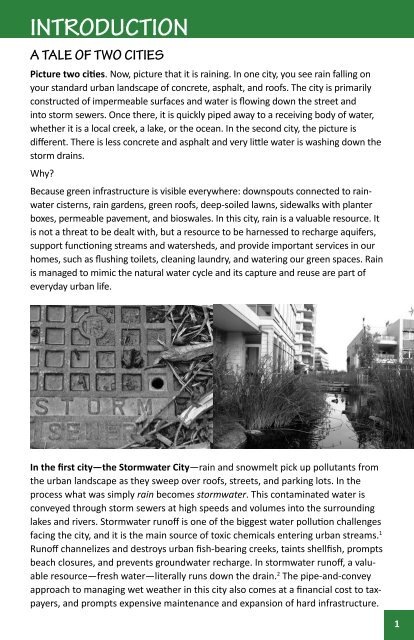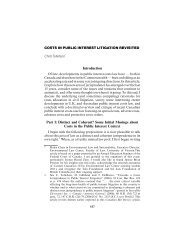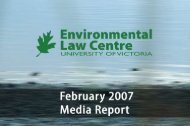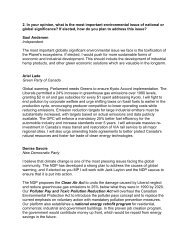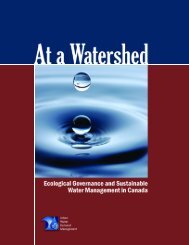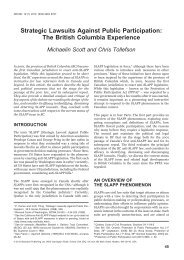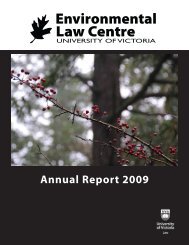Peeling back the Pavement - POLIS Water Sustainability Project
Peeling back the Pavement - POLIS Water Sustainability Project
Peeling back the Pavement - POLIS Water Sustainability Project
You also want an ePaper? Increase the reach of your titles
YUMPU automatically turns print PDFs into web optimized ePapers that Google loves.
introduction<br />
A Tale of two cities<br />
Picture two cities. Now, picture that it is raining. In one city, you see rain falling on<br />
your standard urban landscape of concrete, asphalt, and roofs. The city is primarily<br />
constructed of impermeable surfaces and water is flowing down <strong>the</strong> street and<br />
into storm sewers. Once <strong>the</strong>re, it is quickly piped away to a receiving body of water,<br />
whe<strong>the</strong>r it is a local creek, a lake, or <strong>the</strong> ocean. In <strong>the</strong> second city, <strong>the</strong> picture is<br />
different. There is less concrete and asphalt and very little water is washing down <strong>the</strong><br />
storm drains.<br />
Why?<br />
Because green infrastructure is visible everywhere: downspouts connected to rainwater<br />
cisterns, rain gardens, green roofs, deep-soiled lawns, sidewalks with planter<br />
boxes, permeable pavement, and bioswales. In this city, rain is a valuable resource. It<br />
is not a threat to be dealt with, but a resource to be harnessed to recharge aquifers,<br />
support functioning streams and watersheds, and provide important services in our<br />
homes, such as flushing toilets, cleaning laundry, and watering our green spaces. Rain<br />
is managed to mimic <strong>the</strong> natural water cycle and its capture and reuse are part of<br />
everyday urban life.<br />
In <strong>the</strong> first city—<strong>the</strong> Stormwater City—rain and snowmelt pick up pollutants from<br />
<strong>the</strong> urban landscape as <strong>the</strong>y sweep over roofs, streets, and parking lots. In <strong>the</strong><br />
process what was simply rain becomes stormwater. This contaminated water is<br />
conveyed through storm sewers at high speeds and volumes into <strong>the</strong> surrounding<br />
lakes and rivers. Stormwater runoff is one of <strong>the</strong> biggest water pollution challenges<br />
facing <strong>the</strong> city, and it is <strong>the</strong> main source of toxic chemicals entering urban streams. 1<br />
Runoff channelizes and destroys urban fish-bearing creeks, taints shellfish, prompts<br />
beach closures, and prevents groundwater recharge. In stormwater runoff, a valuable<br />
resource—fresh water—literally runs down <strong>the</strong> drain. 2 The pipe-and-convey<br />
approach to managing wet wea<strong>the</strong>r in this city also comes at a financial cost to taxpayers,<br />
and prompts expensive maintenance and expansion of hard infrastructure.<br />
1


